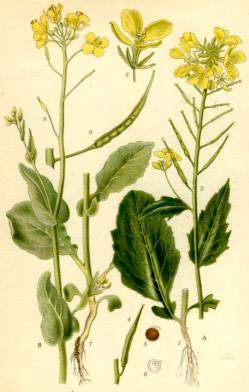Weeds
Brassica campestris L. - Wild turnip.
Taxonomy.
Family Brassicaceae Burnett (Cruciferae Juss.), Genus Brassica L.Biology type.
Spring annual weed.Morphology and biology.
Plant is 75-100 cm in height. Stem is upright, branched, root is thin, unedible. Lower leaves are petiolate, lyre-pinnatipartite, green, pubescent. Upper leaves are sessile, ovate with deep-cordate, amplexicaul base, dove-coloured, glabrous or slightly pubescent. Inflorescence is racemose, flowers are actinomorphic, divided into four parts, petals are golden-yellow, situated crosswise, sepals are horizontally deflected by the end of flowering. Fruit is silicle, with long elongate-conical or subulate tip. Lower part of silicle is multi-seeded, dehiscent, upper part (tip) is indehiscent and has one seed. Seeds are globular, slightly squeezed, from red-brown to red-black in color, lusterless, with fine reticular surface. Plant flowers in May-August, bears fruits in July-September. Minimum temperature for seed germination is 3-4°C. Seedlings appear in spring, in forest zone-during all vegetation period. Seedlings that appear in autumn usually do not over-winter. Maximum productivity is up to 20,000 seeds/plant. Seeds have high germinability, germinate from depth of no more than 5-6 cm, and remain viable up to 6 years in soil.Geographical range.
It occurs across the European part of the Former Soviet Union, in Caucasus, Western and Eastern Siberia, the Far East, and Central Asia. General distribution: as weed - temperate zone of Europe, Asia and America, as cultivated plant - Asia Minor, Afghanistan, northern India, Iran.Ecology.
Anthropochore, autochore. This weed is resistant under continuous growing of one crop. It often forms total herbage cover. B. campestris is undemanding to soil type and quality. It depletes soil nutrients.Economic value.
Brassica campestris is a pernicious weed in forest and forest-steppe zones. It infests all spring crops, both grain and tilled ones, vegetable gardens, and spreads across fallows and sod field in large populations; more rarely grows in meadows, forest belts, along river shores, and roadsides. It is a good bee plant. Before flowering this plant is eaten by all agricultural animals. Sometimes it is grown as an oil plant (its seeds contain up to 48% oil) at a small scale in Transcaucasia and Central Asia. Control measures: early shallow plowing and plowing in autumn; early in spring - soil harrowing which favours weed seed germination, then eradication of seedlings.Reference citations.
Agaev M.G., ed. 1988. Main agricultural weeds in crops of the Leningrad Region. In: Catalog of the VIR World Collection. N. 468. Leningrad: VIR. 36-38 pp. (In Russian)Fomina Z.V. 1962. Weed plants of Buryatia and their control measures. Ulan-Ude: Buryatskoye knizhnoye izdatelstvo. 17 p. (In Russian)
Keller B.A., ed. 1934. Weed plants of the USSR. Leningrad: AN SSSR. V. 3: 56-57. (In Russian)
Komarov V.L, Bush N.A., eds. 1939. Flora of the USSR. Moscow-Leningrad: AN SSSR. V. 8: 462-463. (In Russian)
Nikitin V.V. 1983. Weed plants of the USSR flora. Leningrad: Nauka. 210 p. (In Russian)
Ulyanova T.N. 1998. Weed plants in flora of Russia and other CIS countries. St. Petersburg: VIR. 229 p. (In Russian)


